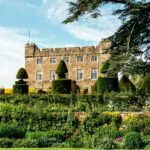The second gateway to the Lakes, after Kendal, Penrith, is the entrance from the north and an ideal place from which to explore the more northerly lakes and fells. It is an old town, believed to have been originally built in 500BC on a site already occupied by the Celts. A stone circle known as “Long Meg and her Daughters” dates from this period and is situated several miles to the north east of the town. Other ancient sites in the area are Maryborough and King Arthur’s Round Table, both of which are nearer to the town.
Penrith was an important centre during the Roman occupation of Britain and many coins and pieces of pottery have been found in the area. The “Giant’s Thumb” is the oldest existing monument in the place. It is a cross of 920 AD, situated in St Andrew’s churchyard and commemorating one Owen Caesarius, King of Cumberland, who is said to be buried here. Penrith was the place where the king held his court, the ancient capital of Cumberland.
The church records date back to 1133 and the walls of the tower are extremely thick. There were originally family connections between the town and the Earls of Warwick in the 14th and 15th Centuries and the church still has one remaining decoration representing the arms of that family. Much of the church was rebuilt in 1719, following a fire. There are some interesting stained glass windows, which include portraits of Richard III and his wife.
Henry III granted the town a charter for a market in 1223. The original seal can still be seen in the town museum, Robinson’s School. The museum building is said to be from the time of the first Elizabeth. It is next to the Town Hall and Library and contains many old artefacts and pictures of Penrith in bygone eras. The Market Square is still host to a twice weekly market and the cattle market still thrives here. Around the square are several small alleys, known locally as yards. These were the places where cattle and sheep were penned in times of emergency, when they were brought into the town for protection against marauders.
Penrith Castle is now within the Castle Park. The Neville family was partly responsible for its construction and Richard III actually lived there for some time. Not much remains today, but there is a ground plan of the original building in the courtyard and a remnant of Bishop Strickland’s Tower is still standing. Much of the original stone has been used for other buildings within the town and traces of it can be found here and there, distinguishable by the red of the sandstone. Other old buildings in the town include the Gloucester Arms Hotel, once the home of Richard III, the 16th Century Two Lions Hotel and a small sandstone house which is now part of a later building and overlooks the churchyard.
A short distance from Penrith is the ruin of Brougham Castle, where James I once stayed. Lowther Castle is a little further away and is in a far better state of preservation, having been largely rebuilt at the beginning of the 19th Century. Dacre Castle is also not far as are the ruins of Kirkoswald Castle. At one time, the borders were well-defended on the English side.




